Your support means a lot, and it helps me keep this site running. I’m really looking forward to getting rid of the ads, and your donation helps!
Thanks again,
Hollis
 Climate change discussions involve two groups of people: those who’ve spent a lot of time researching the issues and have strong opinions (in whatever direction), and those who haven’t put much time in.
Climate change discussions involve two groups of people: those who’ve spent a lot of time researching the issues and have strong opinions (in whatever direction), and those who haven’t put much time in.
Among the second group, anything confusing tends to lead to throwing up their hands and disengaging from debate—which is problematic because climate change is a big deal and we need more people thinking about it. Lately, I’ve noticed a lot of people conflating two issues that relate to climate change, and it seems to directly cause a lot of misunderstanding.
The issues are scarcity and overabundance.
We can expect scarcity of fossil fuels to dominate the energy market at some point in the future. Because the process of making fossil fuels takes many hundreds of human lifetimes, these resources are essentially finite as far as we’re concerned. Since we’re using them up, the amount that’s still available will go down, become more precious, and become more politically contentious. Dependence on fossil fuels will become an even bigger lever in global politics because it will be critical to become or stay friendly with nations that possess fuel reserves.
We can expect climates to change as long as the atmosphere has an overabundance of carbon, and to change faster as the level rises. Storms get nastier, droughts get longer, and a host of other stuff happens (on macro scale). This is largely independent of the chemical source of the carbon, and it’s also somewhat independent of national politics because we’re all sitting on the same planet (although island nations getting flooded and nations with no agriculture because of prolonged drought will think of it politically).
In recent elections, we’ve heard a lot about “clean coal”. Most of what I’ve read suggests that “clean coal” isn’t really a thing, since burning coal puts carbon (and particulates, and other things, …) into the atmosphere whether it’s “clean” or not. This still contributes to the carbon overabundance problem no matter how you deal with it, because it’s still burning fossil fuels.
People talk about opening more of Alaska’s oil fields (or the national strategic petroleum reserves, fracking the Finger Lakes, drilling (baby, drilling!) in the Gulf of Mexico, etc.) as an important step in securing America’s energy independence. This directly addresses one of the fuel scarcity concerns: that a nation dependent on oil is subject to unavoidable pressure from other nations if it cannot supply its needs itself.
But dealing with fuel scarcity and international pressure by doing mountaintop removal coal mining in West Virginia does nothing to deal with the fact that burning that coal will still contribute to the overabundance of carbon dioxide in the atmosphere. It doesn’t matter where the coal comes from; if you burn it, the CO2 level goes up and we burn.
We cannot solve the climate change crisis without addressing both parts: the scarcity of fuels we need and the overabundance of carbon in the atmosphere. To claim that we can fix it by solving one thing without fixing the other is to lie. Converting to natural gas or ethanol isn’t going to help.
Domestic sources of fossil fuels buy us time, perhaps, on the scarcity front—but we still lose the war if global atmospheric carbon rises above the tipping point. Independence doesn’t matter if your nation is under water. We have to solve both problems.
Making a new bridge for my Eastman MD504 oval-hole mandolin!
(also check my Mandolin Pick Comparison article if you’re interested in sound comparisons)
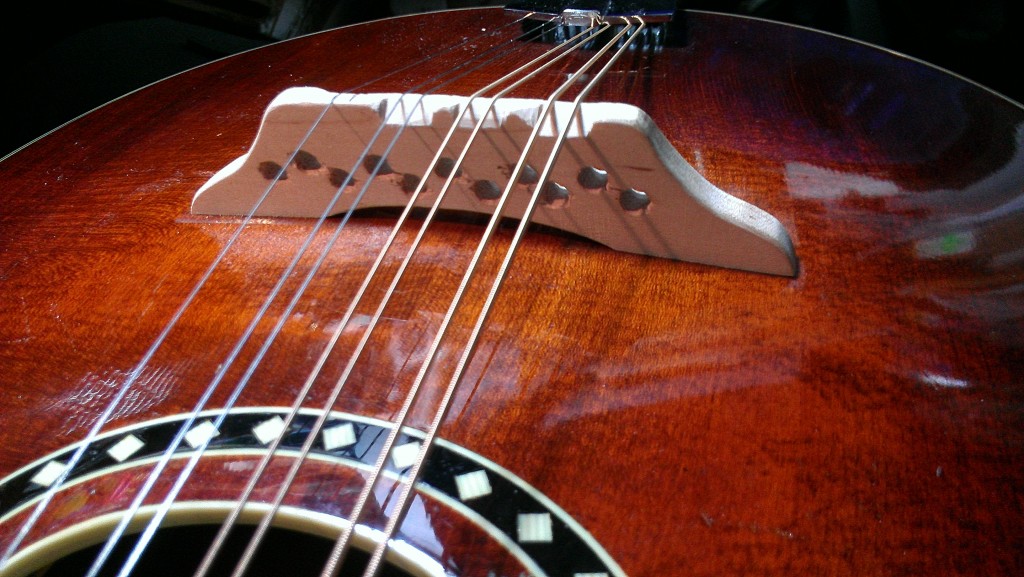
Most archtop mandolins come with an adjustable rosewood bridge like the black one on the left here:
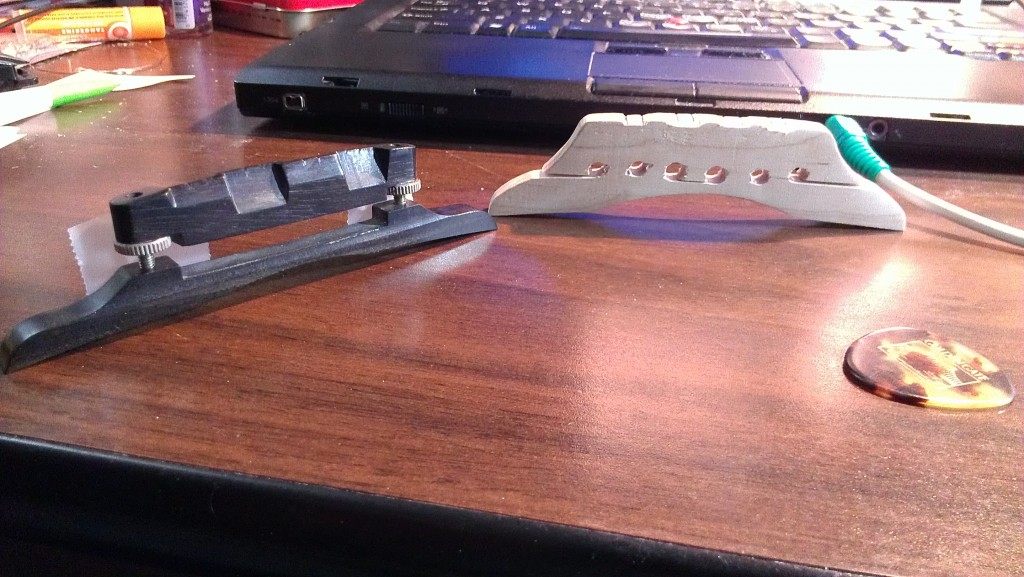
This style of bridge was already in use when Lloyd Loar designed the classic F5 and A5 models that made the Gibson Mandolin-Guitar Manufacturing Company a household name in the US strings world. Orville Gibson had already brought significant innovations to the mandolin world by borrowing techniques like the arched/carved top from the violin lutherie tradition.
(Gibson also belongs to the local history of northern NY, and I feel a sense of connection to him both through our shared homeland and through my work: he was born in Chateaugay, NY, right near where my grandfather lived; he died in Ogdensburg, NY as a resident of the St. Lawrence State Hospital (now known as the St. Lawrence Psychiatric Center), a facility with which I collaborate in my crisis hotline job; and he is buried in Malone, NY, where several of my family members live. A more tenuous connection is that I bought my first mandolin from David Nichols in Malone, NY, and David used to work at St. Lawrence Psychiatric Center. Anyway.)
Adjustable mandolin bridges are fabulous because they permit easy and quick adjustment of action (string height above the frets) by musicians. Action changes with temperature, humidity, the season, and a bunch of other factors, and it’s wonderful to be able to set things right with only a couple of minutes. Adjustable bridges are usually made of rosewood, and they’re cheap, reliable, and seen almost everywhere.
So why change them? Besides the irresistible urge to tinker?
Better sound and better volume, basically. Rosewood is a very hard, dense wood, and the adjustable bridge design involves two steel or brass bolts and two steel or brass thumbscrews. All other things being equal, you get longer sustain on bridges with lower mass, since mass damps vibration and the bridge’s purpose is to conduct vibration from the strings to the instrument’s top. (Bridges also act as frequency filters, transforming the sound and linking up different vibrational modes in different ways, but that’s a bit advanced for this page).
I bought the Eastman MD504 oval-hole mandolin shown here from my friend Tristan Henderson, who plays with Atlantic Crossing along with my Frost and Fire bandmates Viveka and Peter. It has a lovely tone, but I kept feeling like I was having to work very hard to get a decent amount of sound out of it—like it was inefficient. String changes didn’t help, so I decided to take the plunge and try out bridgemaking.
There’s a lot of neat stuff on the internet about making your own mandolin bridges, with much of the foundational work written by Red Henry. One big change is that most DIY bridge-makers use maple (like violins and the rest of the orchestral strings) rather than rosewood or ebony. Maple is a lot less dense than rosewood, although it retains similar hardness. Most DIY builders also build single-piece bridges rather than adjustable ones, optimizing for low mass instead of convenient adjustment.
There’s a lot of science involved with how one carves the bridge: how many holes, what size, where, what shape, etc. I’ve waded fairly deep into the acoustics of it, but there’s too much to write here and, in any case, I’ve built stock bridges from Red Henry’s designs for this test. But if any readers feel so moved, please get in touch and we can geek out about physics.
So, I wanted better tone. I also discovered that the original bridge on the MD504 was bending, slowly but surely, under the weight of string tension:
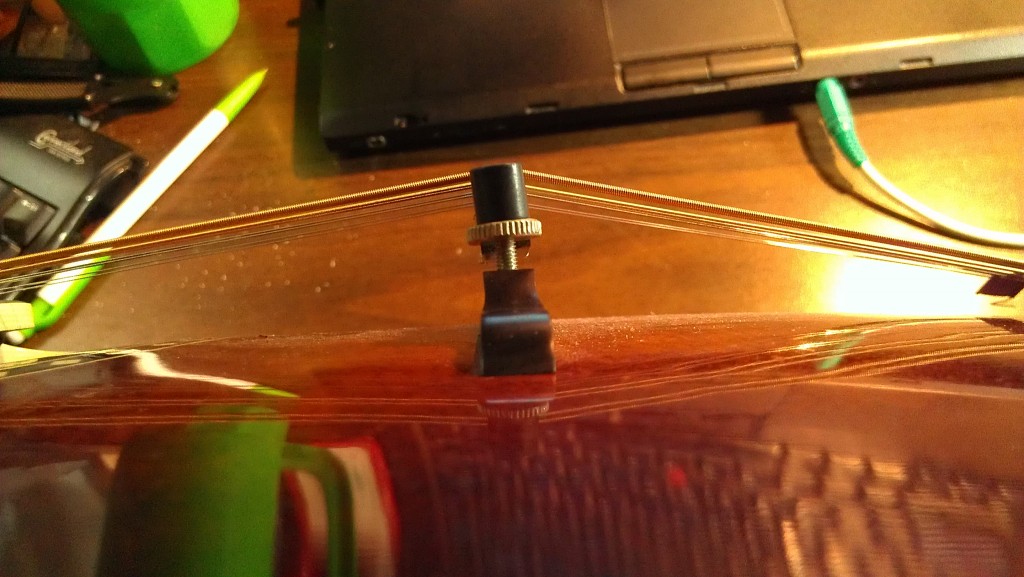
See how far forward it’s tilted, even though the feet of the bridge are flat on the mandolin top? That leads to poor tone conduction and feet that dig into the soft spruce of the instrument’s top. I was concerned that I would break the bridge if I tried to straighten it, plus I wanted a project, so I decided to try making maple bridges.
I’ve been frustrated in reading other people’s mandolin bridge reports that none of them include sound files. They include great descriptions—“the new bridge dramatically improved punch and clarity”, “my bridge doubled the mando’s volume”, “I love the increase in resonance with the new bridge!”, etc.—but no way for the reader to independently compare. This drives me nuts.
So, I made a plan before I got started.
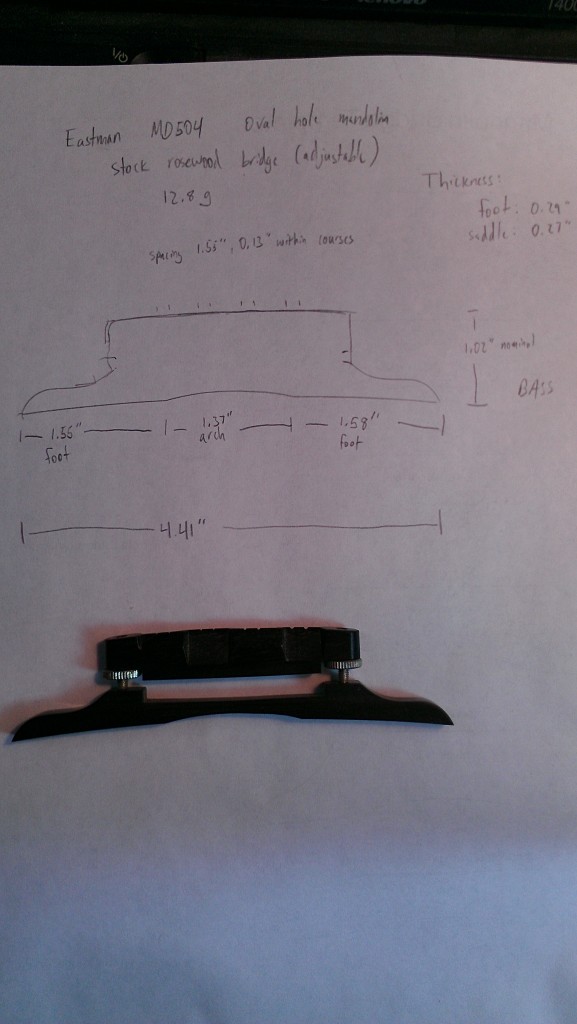
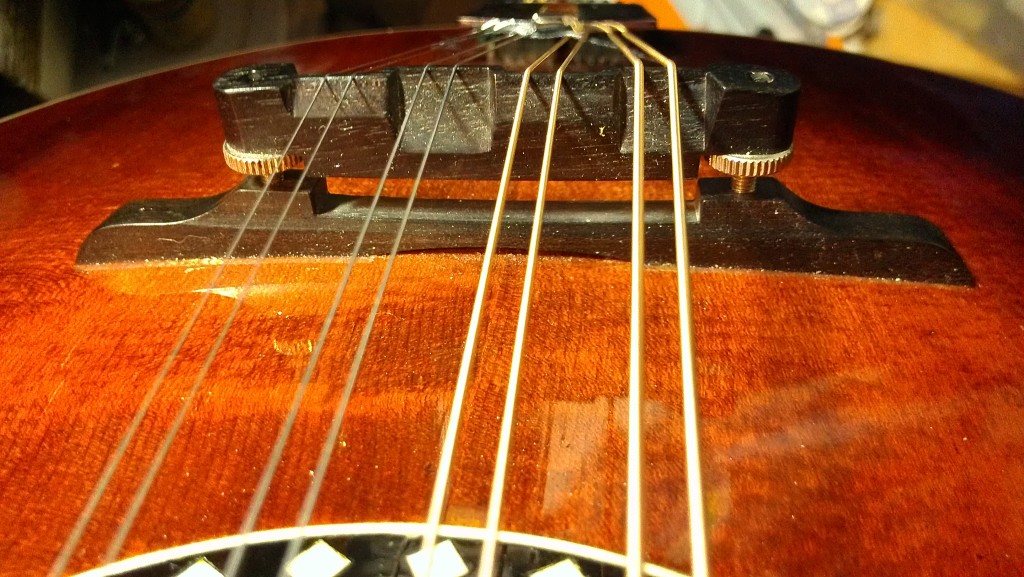
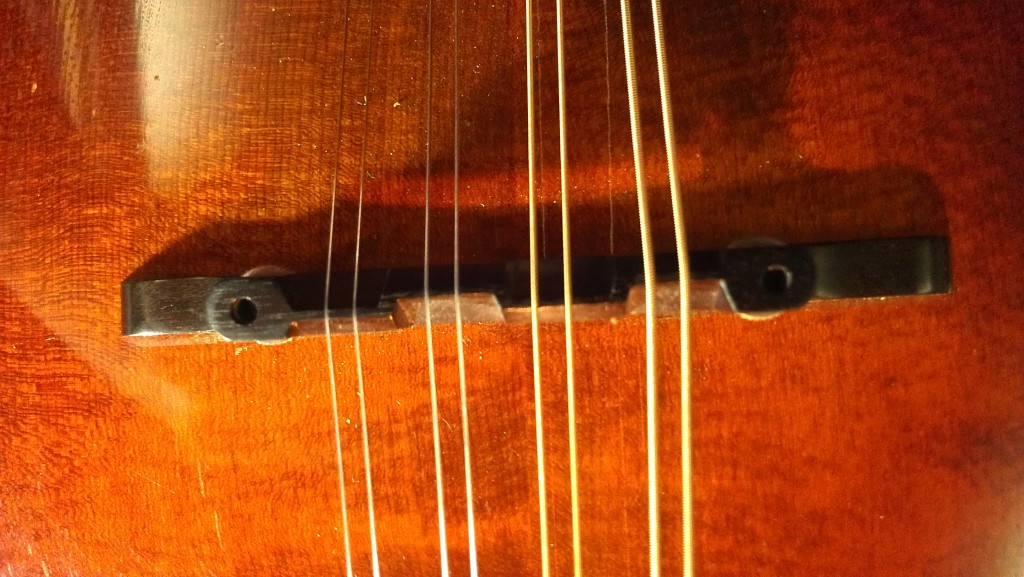
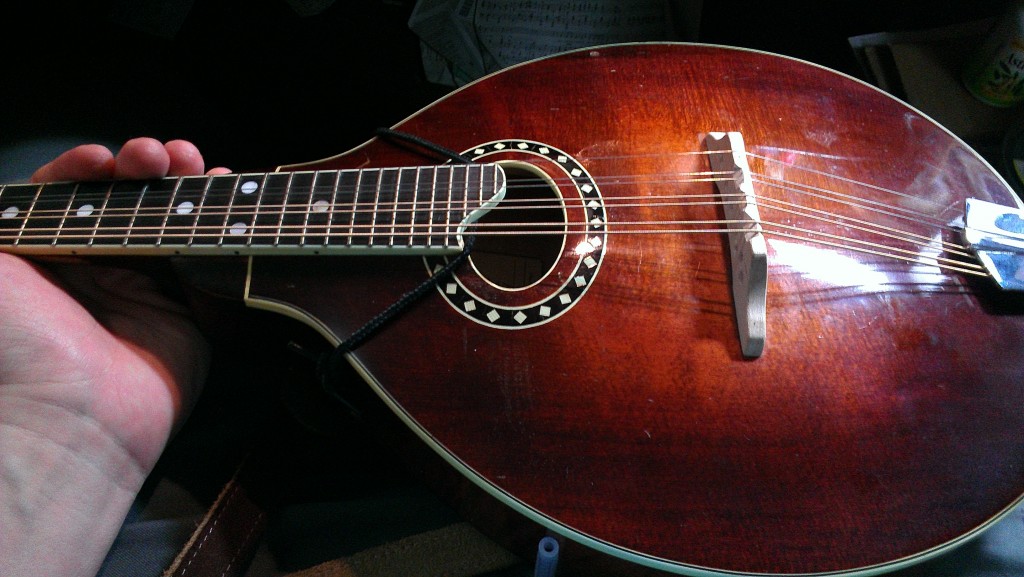
To let you compare without bias, I’m posting recordings of the three bridges identified only by number. There’s a key at the bottom of the page. All recordings were made using a Golden Gate stubby 1.5mm pick with a Tone Gard installed on the back of the mandolin.
I’m posting two sets of recordings: the first is the raw output of the recorder (not normalized), which shows the differences in volume and actual performance; the second is normalized audio (digitally modified so the loudest points of each track are at 0 dB), which shows more of the difference in tone.
Within each grouping, I’ve included the sustain tests (one string course at a time) and a tune, “The Torn Jacket”. On two of the recordings, I alternated between melody and chords; on the other, I forgot, so I added chords afterwards. One thing I learned: sanding and scraping mandolin bridges all night makes your playing worse than usual!
During one of these tests, I broke one of the E (highest-pitched) strings. I elected to continue recording using only one E string rather than restringing the entire instrument, since new strings have a markedly different tonal character that would have obscured the results of the experiment.
As a starting point, I was surprised by how much difference the bridges made in the mandolin’s tone, volume, and responsiveness. From the player’s perspective, all three bridges sound and feel very different. I find that the recordings under-report the differences. This could be due to the difference in position (my ears are above and behind the mandolin; the recorder was level and in front), due to difference in picking, or any of several other factors.
As expected, the maple bridges modified both tone quality and volume. Both of them are noticeably louder than the rosewood adjustable bridge, which seems predictable when you look at the measured weights for each bridge:
The maple bridges also have noticeably longer sustain than the rosewood bridges. (G, D, A, E, plus combined sustain times):
This contributes strongly to the feeling of resonance and efficiency: it’s just less work to play the mandolin with the maple bridges. A given amount of picking force yields a louder sound, which is desirable for injury prevention and comfort. The instrument feels more alive in the hands, and there’s a sense of having more tonal range to work with.
Tonally, I prefer the 11-hole maple bridge. Although its low end feels less powerful to me, I really like the clarity of its higher strings—I feel like they have more of the smoothness I associate with really nice mandolins, with less of the twang and harshness. There’s also a nice resonance to the sound, making this my clear favorite.
I like the tone of the original rosewood bridge next, with its darkness and smoothness most apparent on the normalized recordings. It has some nice variation of sound, but it’s so quiet that I find it frustrating to play. The lack of volume makes the rosewood bridge come in last, even though I like its tone.
Finally, I didn’t love the tone of the 6-hole maple bridge on this instrument. It sounds a little bit stuffy to me, with snappy harshness on the upper strings. It has lovely “thunk” on the lower strings, though. Red Henry suggests that this is a good bridge for bluegrass musicians playing F5-style instruments, and I’d believe it: the F5s I’ve played have a much more treble-heavy sound, and this bridge might lend some bass richness to them. It’s certainly an acceptable bridge even on this A5-style oval-hole mandolin. Weighing its good volume against its lesser tone, I would still pick this bridge over the rosewood adjustable one, since I think being audible is worth some theoretical tone quality.
I prefer the DIY maple 11-hole bridge I made, both in terms of volume and tone. My next favorite is the homemade maple 6-hole bridge with wings, which gets a slight edge because of its volume although its tone is less good. The stock rosewood adjustable bridge comes in last unless you need to adjust your action a lot.
The DIY maple 11-hole mandolin bridge recordings are the ones with only one E string, so they’ll have a bit more E prominence once I restring the instrument.
Thanks again to Red Henry for getting the ball rolling on these designs and providing so many ideas on his website! Check out my Mandolin Pick Comparison article if you get the chance.
I started blogging in September 2013, and some of the things I wrote really sparked discussions and got a lot of hits. Here are the most popular posts I wrote in 2013. Thanks so much to everyone who read them!
This one got a lot of discussion about what it means to provide services for people dealing with homelessness, as well as debate about why we focus on changing appearance instead of substance. Lots of good points on all sides.
This struck a chord for a lot of readers: the idea that complimenting people on their abilities often embarrasses them, where praising their efforts often gives them something to feel good about.
I wrote up a quick guide for emergency preparedness in the ice storm that gripped northern NY in late December 2013. I based it on my experiences in the 1998 ice storm, during which I operated as a radio communications worker for the Red Cross.
I talked about how savings accounts shouldn’t be used as growth vehicles, and how they’re better seen as a form of protection or insurance against loss. Pictures of helmeted guards and Rube Goldberg-esque machines abound in this one.
I’ve been fighting against Lyme disease for the last year and a half, and I wrote about some of the emotional challenges of chronic illness and how I’ve been managing them. I’m honored that it resonated for so many of my fellow Lymies and other people with long-term disease.
I teach crisis hotline volunteers for a living, and we often talk about addressing people’s feelings before dealing with the facts. Here’s how and why to do it, with examples and sample phrases to use.
People talk a lot about the Common Core State Standards for schools, but it seems like a lot of half-truths and misunderstandings pervade the public discussion. I wanted to go read the standards and see what they said; here’s what I found.
I wrote this as a semi-serious parody of the ads seem to appear everywhere on the web, giving you suggestions for being better/faster/stronger/thinner/sexier/smarter/whatever in just one easy step. The advice in here is good, though.
A serious one this time. The grief closet is a metaphor for talking about complicated grieving, the role of trauma and stress over time, and why it’s important to provide crisis services immediately.
At the National Association of Crisis Center Directors annual conference this year, we talked about the need for a list of suggested reading for people taking jobs as crisis center directors. So I made one!
I write a lot of music, and I wrote this tune to honor my friend Jay O’Hara, who blockaded a Massachusetts coal port with his lobster boat in protest of our nation’s ruinous dependence on coal-fired electricity. Bob Mills played with me!
I teach college students, and a lot of them head off to grad school without a firm understanding of the costs they’re going to incur. Some, like loans, are fairly obvious—but they forget the opportunity costs. So I wrote about it, and lots of people piled in on the discussion. You’ll also find a followup.
I use honey badgers to explain why we need to use non-pathologizing language in talking about people who need help.
Long car rides can be pretty tedious, so I wrote down the instructions for a car game of strategy, estimation, timing, and more. Rural people play it with cows; city folks have been playing it with different categories of people, too. Try it!
I’ve loved Antoine de Ste.-Exupery’s Little Prince for a long time, and this is my meditation on why crisis workers need to love the people they’re trying to help.
Here’s the quick monthly roundup for what I’ve written this month, organized by subject. I’ve provided links to make it easier to read the articles.